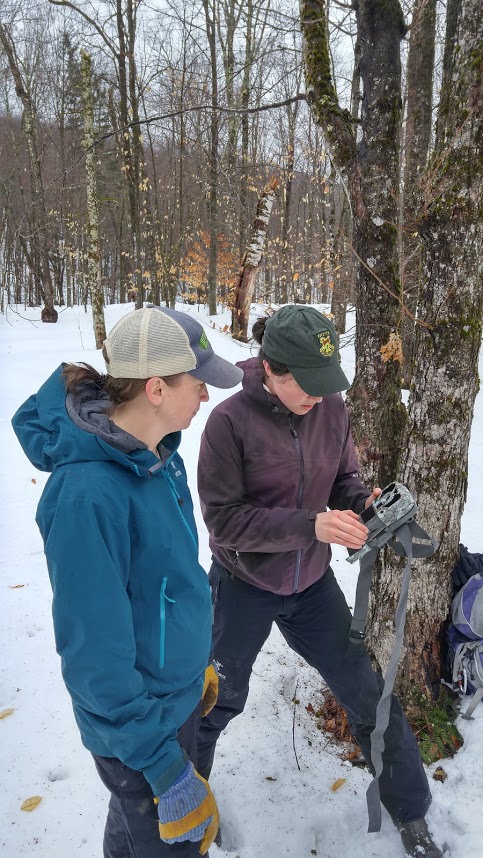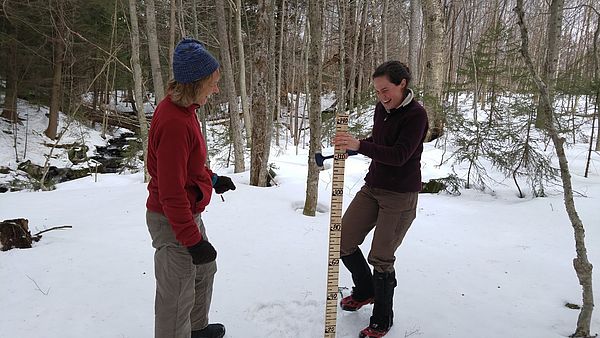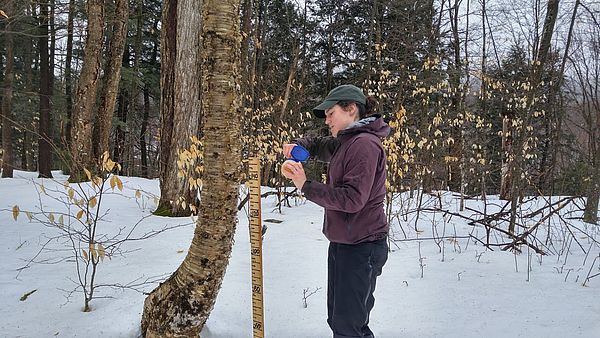Cold Hollow to Canada (CHC) administers two very important citizen science programs, the Keeping Track Monitoring Program (KTMP) and the WildPaths Project. Both have played key roles in increasing our understanding of wildlife habitat connectivity links between large unfragmented blocks of forest in our region. The KTMP focuses on documenting interior forest activity of focal species. Its transects are monitored by tracking teams four times per year, and all are near or within identified habitat connectivity areas. The WildPaths Project focuses on wildlife activity at the pinch points on roadways between large intact forest blocks.
We are pleased to announce that CHC has recently embarked on an additional exciting project, the Mammal Camera Project (MCP), which will enhance the work of our other two citizen science programs. The new MCP was developed in partnership with Vermont Fish & Wildlife (VFW), with the support of a grant from the Wild and Scenic River Committee, which allowed us to purchase three of the seven cameras needed to get started. The project was launched in March of 2018.
Under the direction of Katy Crumley, VFW Fur Bearer Technician, seven cameras were placed within KTMP blocks, throughout the CHC area of the Missisquoi River watershed. The cameras were set up following VFW protocols for their Canada Lynx project. The criteria used for the location of each camera included: potentially suitable habitat for Canada Lynx, including food source (snowshoe hare), water source, refugia, and cover; relative ease of access for monitoring the cameras, and; camera set-up facing north.
Once the location for each camera was selected, a snow stake was installed in the line of sight of where the camera was about to be placed. The stake allows for monitoring the variation in snowpack depth while the camera is in place. A turkey feather on a piece of fishing line was then attached to the top of the stake. The movement of the feather provides a visual lure to animals to investigate. Also, a CD hanging from the fishing line was attached to a nearby tree limb as an additional visual lure due to its movement and shimmering in the light. The CD was placed out of the line of sight of the camera. The final lure used was petroleum jelly which had been impregnated with a (very strong!) skunk scent. Katy told us that Canada Lynx, as well as bobcats, fishers, and other mammals, are drawn to the smell of skunks. This pungent substance was carefully applied to the top of the snow stake. We were warned that it is NOT a good idea to get any of it on clothing or skin! It should be noted that no food bait was used.
After the above items were in place, the camera was attached to a tree about 10 or 15 feet away from the snow stake, with the camera facing the stake, which was north of the camera. The area was also checked for any thin branches or other smaller plants which could move in the wind and trigger the camera. Those were trimmed. It was confirmed that the camera angle was appropriate and that the settings were all correct. This included verifying the date & time stamp, the frequency of photos, sensitivity setting, and so forth.
After the camera was turned on, a whiteboard with the name of the camera, date and time was held in front of it to trigger a photo. This would be the first photo on the SD card when it was retrieved later. This same process occurred at all seven sites.
According to the VFW protocol, the photos need to be retrieved every three months. This corresponds very well to the KTMP protocol of four times per year for transect monitoring. The data gathered from the cameras will then be shared with VFW for their regional project regarding Canada Lynx populations. Will any evidence of the presence of Canada Lynx in our area be provided by data from the seven cameras? Time will tell…. It should be noted that we do hope to expand the MCP by obtaining additional cameras to place in remote areas of the CHC which have been identified as suitable Canada Lynx habitat.
Regardless of whether or not evidence of Canada Lynx is provided by the MCP, it is expected that there will be photos of other mammals, including of focal species for the KTMP. Those findings will undoubtedly serve to enhance the work of KTMP and WildPaths by providing valuable information about resident mammal populations and their behaviors. This information, in turn, will be used for community education about wildlife in the area and the importance of protecting habitat connectivity in our region, as well as to further support CHC’s conservation efforts. This is definitely an exciting opportunity! We will keep you posted on the findings.
As the Cold Hollow to Canada t-shirt says, “You only: SEE what you know, LOVE what you see, PROTECT what you love.” Our hope is that having the opportunity to see our local wildlife in the photos obtained through the MCP will inspire our supporters to love and protect them and this amazing area where we all live.


